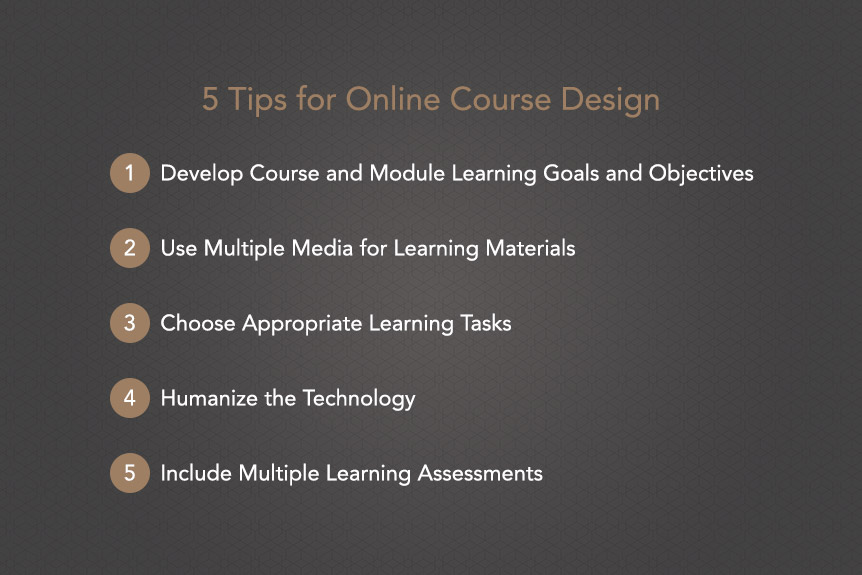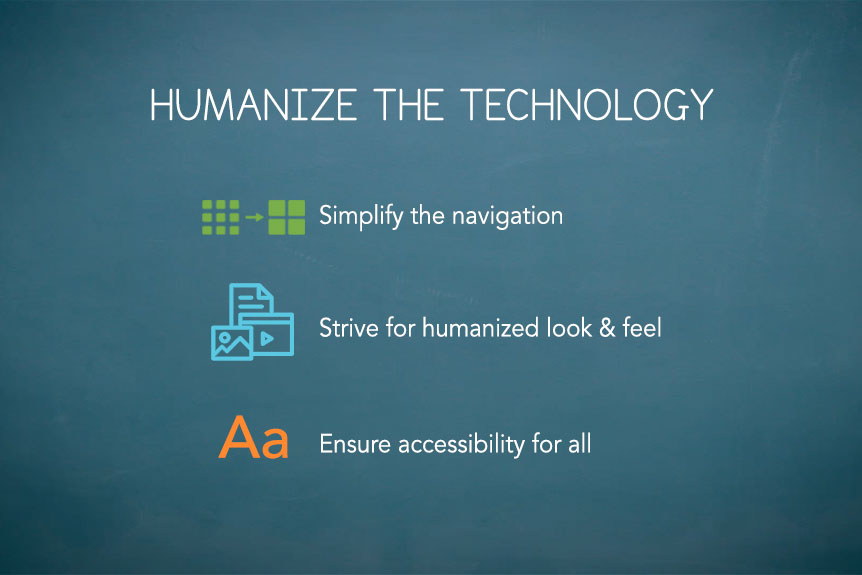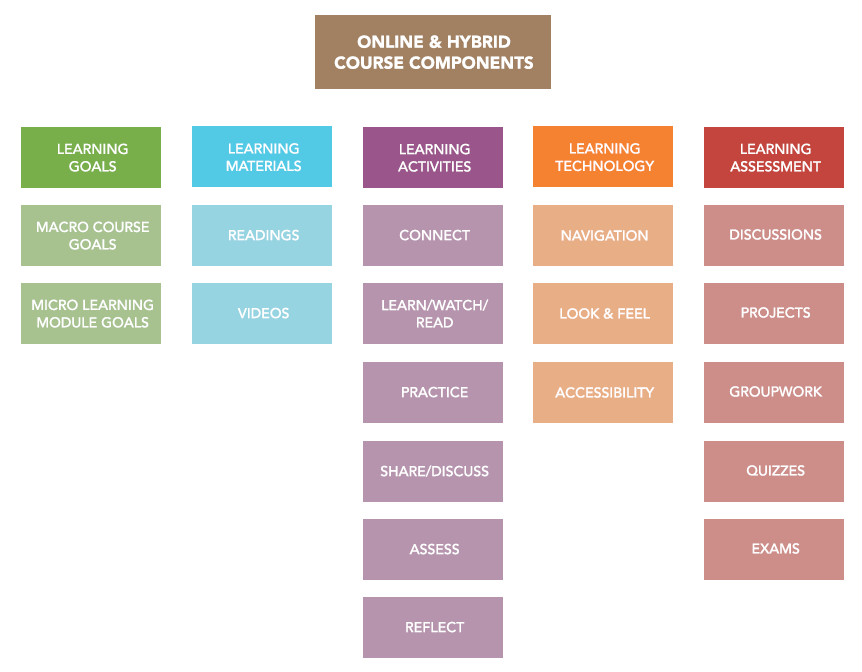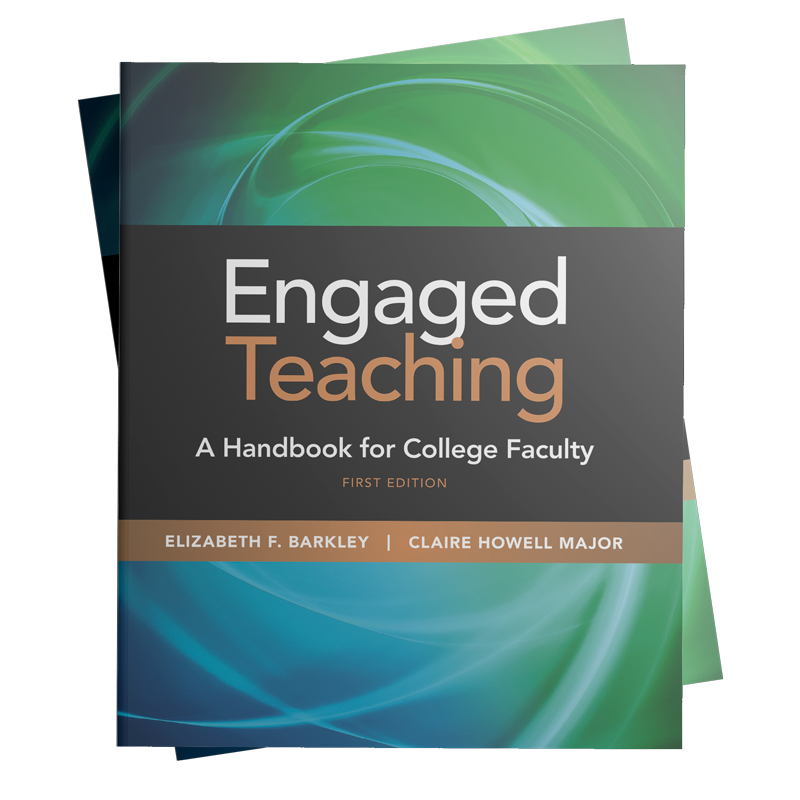
After years – even decades – of teaching onsite, many instructors are able to teach a traditional, classroom-based course without having laid out the entire course in advance. This approach doesn’t work well in the online classroom, however, as online course delivery requires more fully developing the course ahead of time. Thus, when teaching online, the process of course design is essential. Online course design requires a wide range of skills and tools and managing both the design and the technical aspects of the course.
A Brief Overview of Online Course Design
When engaging in course design, the concept of instructional alignment is useful to consider. Instructional alignment begins with the identification of learning goals. Those goals then direct other decisions, including how you will help students achieve these goals (materials and methods), what tools can best help you help students achieve them (technologies), and how you will know if the goals have been met (assessment).
We illustrate the idea of instructional alignment in online courses in the following figure:
 In this model, one element leads to the next. For example, if you are teaching an English class, you might have a learning goal of critical thinking, with a specific objective that learners will critically evaluate a play. Your learning materials might include the specific play to be evaluated as well as an article or chapter describing a model of critical evaluation. For your learning activities, you might ask learners to read the materials and then practice critical evaluation through Active Reading Documents in which your questions lead students through a critical analysis that prepares them to then write a report on their own. For the technology, you might use a Learning Management System (LMS) and have the materials available within it as well as a downloadable template for the Active Reading Documents. For the assessment, students might write a formal report using the evaluation model to critically evaluate the play. All of these key elements in the instructional alignment model should be determined before an online course goes live. The following are tips related to instructional alignment during course design.
In this model, one element leads to the next. For example, if you are teaching an English class, you might have a learning goal of critical thinking, with a specific objective that learners will critically evaluate a play. Your learning materials might include the specific play to be evaluated as well as an article or chapter describing a model of critical evaluation. For your learning activities, you might ask learners to read the materials and then practice critical evaluation through Active Reading Documents in which your questions lead students through a critical analysis that prepares them to then write a report on their own. For the technology, you might use a Learning Management System (LMS) and have the materials available within it as well as a downloadable template for the Active Reading Documents. For the assessment, students might write a formal report using the evaluation model to critically evaluate the play. All of these key elements in the instructional alignment model should be determined before an online course goes live. The following are tips related to instructional alignment during course design.
 1. Develop Course and Module Learning Goals and Objectives
1. Develop Course and Module Learning Goals and Objectives
Most of us are familiar with the idea of developing course goals and objectives; after all, we usually have to include course level goals and objectives in every syllabus we create. But not all of us are as familiar with developing goals for specific learning modules. When we teach online, developing, and then displaying more targeted micro-goals for specific modules helps make our learning expectations clear.
2. Use Multiple Media for Learning Materials
Traditionally, many of us share content by asking students to read a chapter or article and then we elaborate by presenting additional content through lectures. We can accomplish these forms of sharing content in similar ways online. Many resources are available to present text versions of lectures, and we can also present either synchronous lectures through video conferencing or asynchronous pre-recorded video lectures online. In addition, there are a range of free resources available online, such as pre-recorded videos and free open educational resources (OERs). A mix of media (text, video, audio, graphics) is typically more effective than using only one type because the variety can help keep students more engaged.
3. Choose Appropriate Learning Tasks
It is important to think through what students will do in your online course. Common instructional tasks in online courses include the following:
- Connect—Activate students’ prior knowledge of the content so that learners can make better connections to new content through an activity such as a Background Knowledge Probe.
- Learn/Watch/Read— Provide learners with the new content.
- Practice—Implement activities that reinforce their new learning.
- Share/Discuss—Enable students to find personal relevance and share their experiences with their peers, perhaps through a discussion thread. Consider for example using a Think-Pair-Share.
- Assess—Ask students to demonstrate learning, whether through a quiz, assignment, project, or other.
- Reflect— Challenge students to reflect on what they have learned.
Aim for having the same kinds of activities due on the same days of the week. If for example, you do a discussion board each week, choose the day when students will post (for example have discussions due on Wednesday and responses due on Friday). If they have an assessment to complete each week, choose a different due day for that activity (for example, have the assessment due on Thursday), and so forth.
 4. Humanize the Technology
4. Humanize the Technology
Technology can serve as a mediator between people. A few suggestions for accomplishing this are as follows:
- Simplify the Navigation—Many Learning Management Systems make choices for you, including what will be in the navigation bar. Think through how students will work their way through the course and what students really need to see in the navigation menu. Unnecessary items can result in overwhelmed students. Providing clarity and ensuring intuitive organization of materials can improve learner satisfaction as well as promoting deeper learning.
- Strive for a Humanized Look and Feel—There is a tendency in online courses to use built-in icons and heavy text. Graphics, images, and short videos can create a warmer look and a more human-friendly feel to the course.
- Ensure Accessibility—Effective online courses should be accessible to all learners. One way to do this is to make sure courses are “universally designed.” Universal Design for Learning (UDL) is built on the idea that all learning experiences should be purposefully constructed to be “barrier free” and accessible by providing multiple and flexible methods of the following elements:
- Presentation of content (e.g., voice-to-text applications, screen readers, digital books).
- Alternatives for students to demonstrate what they have learned (e.g., concept mapping).
- Engagement to tap into diverse learners’ interests, challenge them appropriately, and motivate them to learn (choices among various scenarios for learning the same competency).
5. Include Multiple Learning Assessments
While one assessment alone can generate evidence to make decisions about student learning and development, multiple measures encourage more comprehensive and accurate assessment. This benefits not only the students who are learning but also the instructors who are doing the teaching. Consider the following learning artifacts commonly used to assess student learning in online courses.
- Discussion Posts
- Groupwork Products
- Quizzes
- Exams
- Written or Video Assignments
- Digital Projects or Portfolios
Consider providing students with choices for assignments, such as what to write about for the assignment or how to respond to a discussion post or even which assignments they will complete.
In conclusion, online course design requires concerted time and attention. To summarize some of the key points we have described, we have further developed our instructional alignment figure for online courses as follows:

Try incorporating these teaching techniques into your online course design.
Background Knowledge Probe
View main video here: View Technique →
View online adaptation here:
Think Pair Share
View main video here: View Technique →
View online adaptation here:
Active Reading Documents
View main video here: View Technique →
View online adaptation here:
Sign Up for Our Newsletter
Email us to receive information about new blog posts.
Suggested Citation
Barkley, E.F., & Major, C.H.Gutenson, L. D., & Morris, S. J. (n.d.) . 5 tips for engaging online course design. CrossCurrents. https://kpcrossacademy.ua.edu/engaging-online-course-design/

Engaged Teaching
A Handbook for College Faculty
Available now, Engaged Teaching: A Handbook for College Faculty provides college faculty with a dynamic model of what it means to be an engaged teacher and offers practical strategies and techniques for putting the model into practice.





